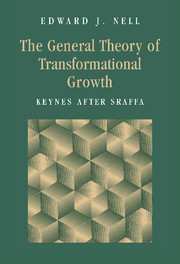Book contents
- Frontmatter
- Contents
- Preface
- Acknowledgments
- Part I History or equilibrium?
- Part II Method and approach: the active mind
- Part III Money and the Golden Rule
- PART IV The wage-profit trade-off
- 7 The Classical system: the Golden Rule, labor, and the wage-profit trade-off
- 8 The Classical system: gravitation and market adjustment
- 9 Cycles and growth: market adjustment in Craft conditions
- Part V Investment and Mass Production
- Part VI Money and fluctuations in the modern economy
- Conclusions
- Bibliography
- Index
7 - The Classical system: the Golden Rule, labor, and the wage-profit trade-off
Published online by Cambridge University Press: 21 January 2010
- Frontmatter
- Contents
- Preface
- Acknowledgments
- Part I History or equilibrium?
- Part II Method and approach: the active mind
- Part III Money and the Golden Rule
- PART IV The wage-profit trade-off
- 7 The Classical system: the Golden Rule, labor, and the wage-profit trade-off
- 8 The Classical system: gravitation and market adjustment
- 9 Cycles and growth: market adjustment in Craft conditions
- Part V Investment and Mass Production
- Part VI Money and fluctuations in the modern economy
- Conclusions
- Bibliography
- Index
Summary
In Chapters 5 and 6 we considered a simple two-sector model and developed an account of circulation based on the specializations of the sectors, and their interdependence. This must now be generalized. The model concerns manufacturing; we take it for granted that a primary sector supplies raw materials – and earns differential rents. A tertiary sector supplies services to both households and buinesses; its circulation was examined in Chapter 5. Neither will be considered in this chapter. First, we need to explain the conception of the wage and of labor here, then we must develop a general account of the relationships between the Golden Rule, the wage-bill/capital requirements condition, and the wageprofit trade-off, and finally we must extend these results to fixed capital and relate the analysis to macroeconomics.
This will not be an easy project, and, paradoxically, familiarity with the subject may make it even more difficult. The problem is not analytical – neither the model nor its mathematics is especially complex. The issues are conceptual. In particular, while the analysis put forward here looks very similar to many recent Classical studies, it differs from most in at least the following respects:
Two distinct sets of industries are defined, capital goods and consumer (wage) goods
The Golden Rule, labor, and the wage-profit trade-off
The amount of labor is measured in basic wage goods
The wage is divided into basic and net portions
- Type
- Chapter
- Information
- The General Theory of Transformational GrowthKeynes after Sraffa, pp. 292 - 359Publisher: Cambridge University PressPrint publication year: 1998



